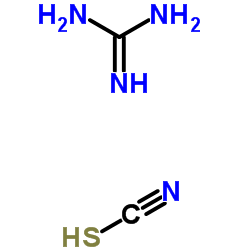


We are Guanidine Thiocyanate CAS:593-84-0 manufacturer and supplier in China, Pls send inquiry of to info@nbinno.com of visit www.nbinno.com our official website should you have any interests

Product Description:
Product Name: Guanidine thiocyanate CAS NO: 593-84-0
Synonyms:
Thiocyanic acid, compd. with guanidine (1:1);
thiocyanic acid,guanidine salt;
guanidine monothiocyanate;
Chemical & Physical Properties:
Appearance: White powder
Assay :≥99.0%
Density: 1.103 g/mL at 20ºC
Boiling Point: 132.9℃ at 760 mmHg
Melting Point: 118-122℃
Flash Point: 34.2℃
Refractive Index: n20/D 1.482
Stability: Stability Stable, but light sensitive. Incompatible with acids (contact releases very toxic gas), strong oxidising agents.
Storage Condition: Store at RT.
Safety Information:
RTECS: XL1225000
Hazard Class: 8
Safety Statements: S13-S61
HS Code: 2925290090
Packing Group: III
WGK Germany: 2
RIDADR: UN 1759
Risk Statements: R20/21/22; R32; R52/53
Hazard Code: Xn
Symbol: GHS05, GHS07
Caution Statement: P260; P280; P301 + P312 + P330; P303 + P361 + P353; P304 + P340 + P310; P305 + P351 + P338
Supplemental Hazard Statements: Contact with acids liberates very toxic gas.
Hazard Declaration: H302 + H312 + H332; H314; H412
Signal Word: Danger
Guanidinium thiocyanate (GITC) is a chemical compound used as a general protein denaturant, being a chaotropic agent, although it is most commonly used in the extraction of DNA and RNA.
Note: this compound may also be recognized as guanidine thiocyanate. This is because guanidinium is the conjugate acid of guanidine and is called the guanidinium cation, [CH6N3]+.
Guanidinium thiocyanate can be used to deactivate a virus, such as the influenza virus that caused the 1918 ”Spanish flu”, so that it can be studied safely. This application is presumably based on its denaturation activity.
Guanidinium thiocyanate is also used to lyse cells and virus particles in RNA and DNA extractions, where its function, in addition to its lysing action, is to prevent activity of RNase enzymes and DNase enzymes by denaturing them. These enzymes would otherwise damage the extract.
A commonly used method is guanidinium thiocyanate-phenol-chloroform extraction. It is not strictly necessary to use phenol or chloroform if extracting RNA for Northern blotting or DNA for Southern blot analysis because the gel electrophoresis followed by transfer to a membrane will separate the RNA/DNA from the proteins. Additionally, since these methods use probes to bind to their conjugates, peptides that get through the process don”t generally matter unless a peptide is an RNase or DNase, and then only if the enzyme manages to renature, which should not occur if proper protocols are followed. A possible exception might be when working with temperature extremophiles because some enzymes of these organisms can remain stable under extraordinary circumstances.
If you are interested in our products or have any questions, please feel free to contact us!
Products under patent are offered for R & D purpose only. However, the final responsibility lies exclusively with the buyer.
Related Products:cis,cis-[Mn(CO)2(dppe)(P(OPh)3)2][ClO4] manufacturer | Thiazolo[4,5-b]pyridine, 6-chloro-2-methyl- supplier | 4-(3′-Octyl-[2,2′;5′,2′]terthiophen-5-yl)-pyridine producer.
| Product Name | |
|---|---|
| Chloroiridic acid Cas:110802-84-1 | View Details |
| sodium 4-amino-1-naphthalenesulfonate Cas:130-13-2 | View Details |
| 7-Azabenzotriazol-1-Yloxytris(Dimethylamino)Phosphonium Hexafluorophosphate | View Details |